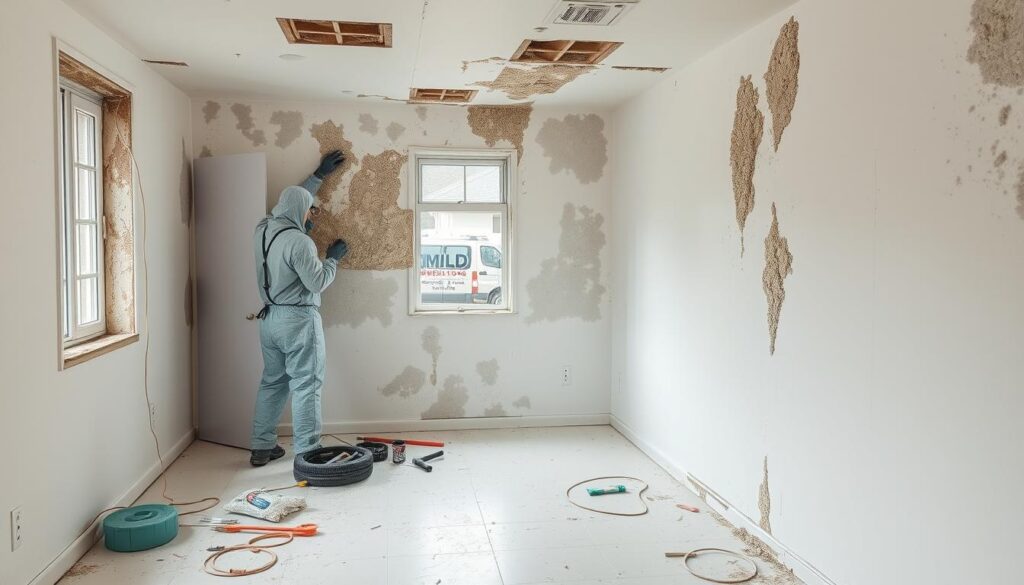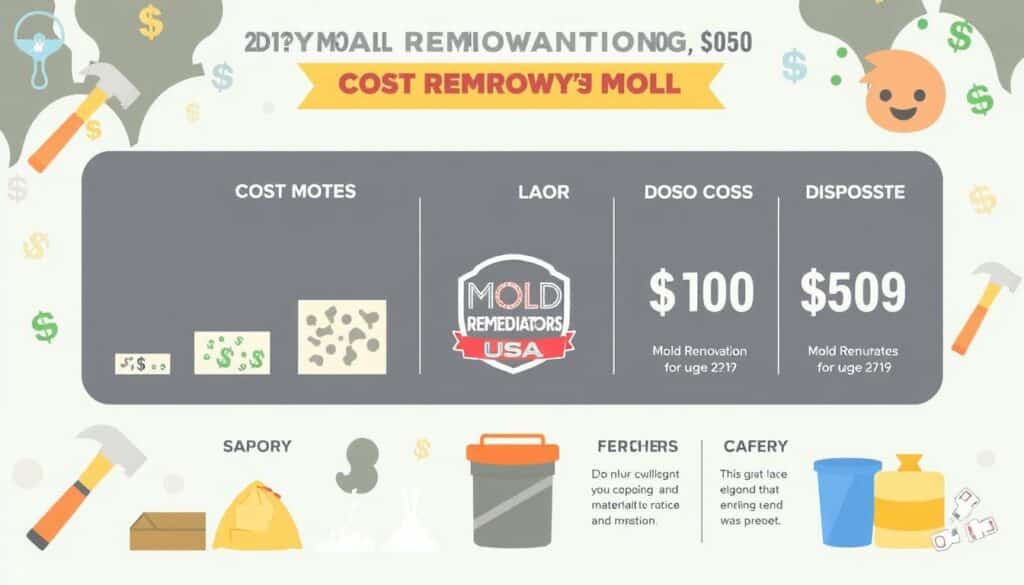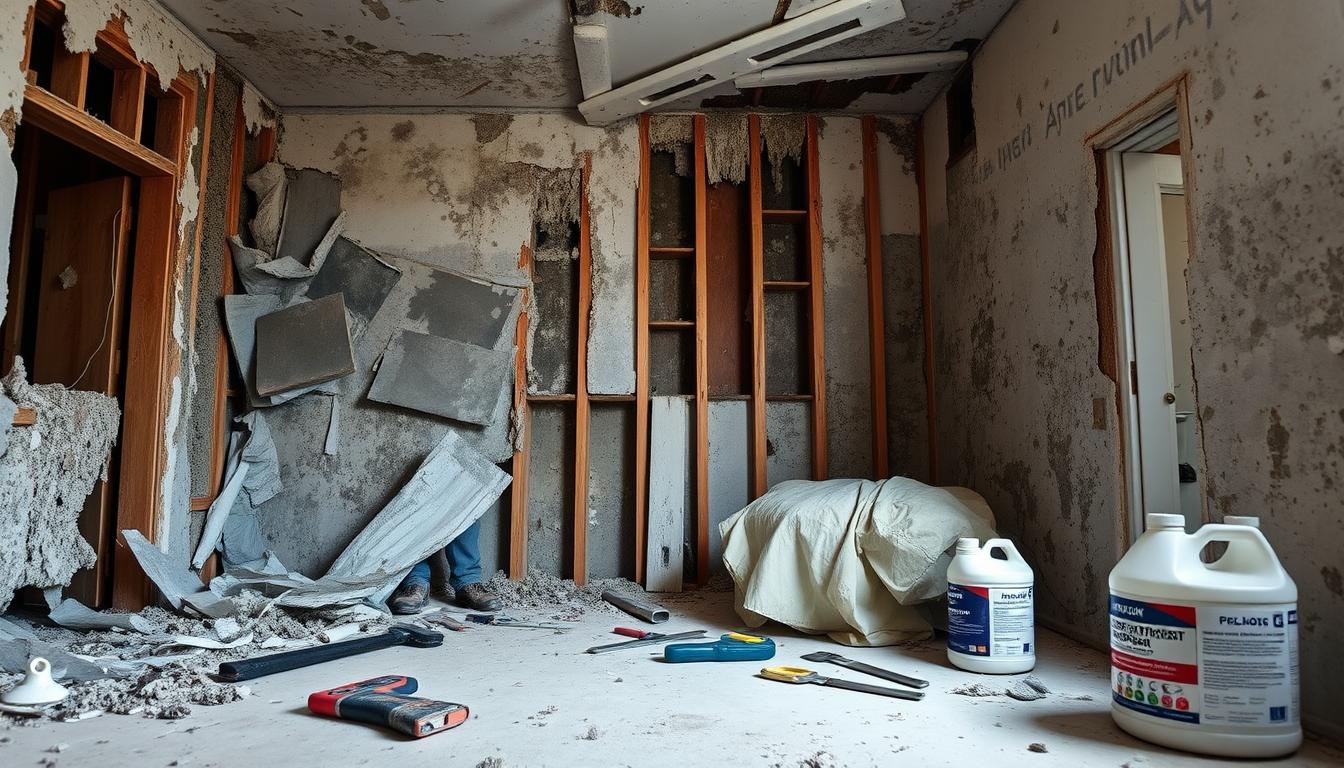Did you know mold removal can cost over $30,000 for a whole house? This shows how much mold can cost. I’ll explain the costs of removing moldy drywall and what affects these prices.
Mold removal costs range from $1,500 to $9,000, averaging $3,500. Removing mold from drywall can cost between $1,000 and $12,000. The cost depends on how much mold there is and where it is in your home.
Professional mold removal costs $10 to $30 per square foot. For a 1,000-square-foot home, expect to pay about $2,500. A 2,000-square-foot home might cost around $5,000. Prices can change based on the type of mold and how hard it is to get to.
When planning for mold removal, remember labor is about 60% of the cost. Mold removal experts charge an average of $99 per hour, with a median of $75 per hour. These prices cover the skills and tools needed to safely remove mold.
Key Takeaways
- Mold removal costs can range from $1,500 to $9,000 on average
- Drywall mold remediation typically costs between $1,000 and $12,000
- Professional mold removal averages $10 to $30 per square foot
- Labor accounts for about 60% of total mold remediation costs
- The extent of mold damage significantly impacts the overall cost
- Whole-home mold removal can exceed $30,000 in severe cases
Understanding Mold Contamination in Drywall
Mold in drywall is a big problem that can harm your home and health. I’ll talk about the types of mold in drywall, health risks, and how to spot mold growth.
Types of Mold Commonly Found in Drywall
Drywall can get many types of mold. Common ones are Alternaria, Aspergillus, Chaetomium, and Stachybotrys chartarum (black mold). These fungi love damp places, making wet drywall a perfect spot to grow.
Health Risks Associated with Mold Exposure
Mold exposure can cause many health problems. Symptoms include allergies, breathing issues, and in bad cases, toxin poisoning. People with weak immune systems, allergies, or breathing issues are more at risk.
| Health Risk | Symptoms |
|---|---|
| Allergic Reactions | Sneezing, runny nose, itchy eyes |
| Respiratory Issues | Coughing, wheezing, shortness of breath |
| Toxin Exposure | Headaches, fatigue, skin irritation |
Signs of Mold Growth Behind Drywall
Finding mold behind drywall is hard, but there are signs to look for:
- Musty odors
- Visible discoloration on walls
- Warping or peeling of paint or wallpaper
- Increased allergy symptoms indoors
If you think there’s mold, act fast. The cost to remove mold from drywall varies a lot. For small areas, it’s $150 to $300. But for big areas or whole-house cleanups, it can cost $5,000 to $10,000 or more. The price depends on how much mold there is and what kind it is.
Getting a professional to check is important. They can tell you how bad the mold is and how to fix it. If you think you have mold, get expert help right away.
Factors Affecting the Cost of Mold Removal
Several key factors influence the cost of fixing moldy drywall. I’ll explain what affects the overall cost.
Extent of Mold Contamination
The size of the moldy area is a big factor. Larger areas need more time, labor, and materials. On average, it costs $10 to $25 per square foot. Homeowners usually pay around $2,230 for the whole job.
Location of Affected Drywall
The location of moldy drywall affects costs. It impacts how easy it is to access and any structural issues. Here’s a breakdown of average costs for different areas:
| Area | Average Cost Range |
|---|---|
| Attic | $1,000 – $4,000 |
| Basement | $500 – $3,000 |
| Bathroom | $500 – $1,000 |
| Crawl Space | $500 – $2,000 |
| Drywall | $1,000 – $20,000 |
Type of Mold Present
Different molds need different treatments, which affects the cost. For example, Fusarium removal can cost up to $8,000. Other molds might be cheaper. Costs can range from $500 to $10,000, depending on the company and mold type.

Professional mold removal often includes extra services like inspection and testing. These usually cost between $450 and $800. These factors together determine the final cost to fix moldy drywall. They ensure a complete and safe mold removal process.
Average Cost Range for Drywall Mold Removal
When I need to get rid of moldy drywall, I look at several factors that affect the price. The cost to treat moldy walls can change a lot. This depends on how much damage there is and the size of the area.
For small areas of 10 to 100 square feet, the cost is between $500 and $1,500. Medium areas of 100 to 300 square feet might cost $1,500 to $6,000 to fix. These prices match the national average of $2,254 for mold removal.
Bigger mold problems covering 300 to 1,000 square feet can cost $6,000 to $15,000. If the whole house is affected, the cost can go up to $10,000 – $30,000.
The starting price to clean mold on a wall is $1.99 – $2.42 per square foot. This price can go up because of labor and equipment costs. Also, adding 13% to 22% for general contractor overhead and markup is common.
| Area Size (sq ft) | Cost Range |
|---|---|
| 10-100 | $500 – $1,500 |
| 100-300 | $1,500 – $6,000 |
| 300-1,000 | $6,000 – $15,000 |
| 1,000+ | $15,000 – $30,000 |
Keep in mind, these are just estimates. The real cost to remove moldy drywall can change. This depends on the type of mold, where it is in the house, and local labor rates.
Cost to Remove Drywall with Mold: Detailed Breakdown
Understanding the costs of moldy wall repair is key. I’ll explain the main factors that affect the cost of replacing drywall and removing mold.
Labor Costs
Labor is the biggest part of mold removal costs. It can cost between $10 and $30 per square foot. About 60% of this is for labor. Mold removal experts usually charge $99 per hour, with a median of $75.
Material Costs
Materials like plastic sheeting, HEPA filters, and cleaning solutions are needed. These costs are included in the square footage price. For a 1,000-square-foot home, mold removal can cost about $2,500. A 2,000-square-foot home might cost around $5,000.

Disposal Fees
Disposal fees depend on local rules and the amount of waste. These fees are part of the total cost. They can increase the cost, especially for big projects.
| Cost Component | Typical Range | Average Cost |
|---|---|---|
| Labor | $75 – $99 per hour | $87 per hour |
| Materials | $2.50 – $25 per sq ft | $13.75 per sq ft |
| Drywall Replacement | $50 – $80 per sq ft | $65 per sq ft |
| Repainting | $2 – $6 per sq ft | $4 per sq ft |
The total cost for moldy wall repair can change a lot. It depends on the damage and your project’s needs. For big jobs, like whole-house remediation, costs can be from $10,000 to $30,000.
Professional vs. DIY Mold Removal: Pros and Cons
I’ve had to decide between DIY mold removal and hiring professionals. Let’s look at the good and bad of each option to help you choose wisely.
DIY mold removal can save money for small problems. You can spend $50 to $300 to handle minor issues. But, DIY methods often only get rid of surface mold. This leaves hidden mold to grow.
Professional mold remediation services gives a full solution. Experts do detailed checks, use special tools, and take steps to prevent future problems. The cost can be $2,363 on average, but it can be more or less based on the size and damage.
| Aspect | DIY Mold Removal | Professional Mold Remediation |
|---|---|---|
| Cost | $50 – $300 | $1,223 – $3,750 (average range) |
| Effectiveness | May only remove surface mold | Addresses visible and hidden mold |
| Health Risks | Exposure to mold spores and chemicals | Minimized with proper safety measures |
| Equipment | Basic household cleaners | Specialized tools and techniques |
When choosing, think about health risks. DIY can expose you to mold spores and harmful chemicals. Professionals use safe methods and tools to remove mold safely.
For big mold problems or if mold keeps coming back, get professional help. They not only remove mold but also fix the moisture issues to stop it from coming back. Getting your home mold-free is often worth the cost.
“Prompt mold removal helps prevent its spread to other home areas and reduces the chances of future infestations, maintaining a healthy living environment.”
Your decision depends on the mold problem’s size, your skills, and how much risk you’re willing to take. While DIY might work for small issues, hiring pros ensures your home is mold-free and keeps you and your property safe.
Steps Involved in Professional Mold Remediation
Understanding the mold remediation process is key when dealing with drywall contamination. I’ll explain the professional mold removal steps to give you a clear idea of what to expect.
Inspection and Assessment
The first step is a thorough inspection. A professional mold inspector may charge between $200 to $600 for a site visit, lasting two to five hours. They’ll check how much mold there is and find where the moisture is coming from.
Containment and Air Filtration
After finding the mold, professionals set up barriers to stop mold spores from spreading. They use special equipment like HEPA air filters and negative air pressure systems to clean the air during the process.
Removal of Contaminated Materials
The next step is removing mold-infested materials. For small areas less than 10 square feet, homeowners might do it themselves. But for bigger or more severe cases, professional help is needed. Costs can range from $500 to $6,000, depending on the damage.
Cleaning and Sanitizing
After removal, the area is cleaned and sanitized with antifungal solutions. Professionals then dry the area completely to stop mold from coming back. The whole mold remediation process usually costs between $1,225 to $3,750, averaging around $2,360.
| Remediation Area | Cost Range |
|---|---|
| Crawlspaces only | $500 – $4,000 |
| Ducts, crawl spaces, walls, and attics | $2,000 – $6,000 |
| Widespread structural damage | $10,000 – $30,000+ |
The cost and time for mold remediation can change a lot. It depends on how bad the infestation is and where it is. Always get a professional for an accurate assessment and quote.
Additional Costs to Consider
When dealing with mold, it’s crucial to factor in extra expenses beyond the initial removal. I’ll break down some key additional costs you might encounter during the process.
Mold Testing and Inspection Fees
Before tackling any mold issue, a thorough inspection is essential. Mold inspection costs typically range from $300 to $1,000, depending on your home’s size. For an average-sized home, you can expect to pay around $650 for a comprehensive mold inspection. If specific mold testing is required, it can add $450 to $800 to your total expenses.
Repairs and Restoration of Affected Areas
After mold removal, restoration is often necessary. The cost varies based on the affected area and extent of damage. Here’s a breakdown of potential restoration costs:
| Area | Cost Range |
|---|---|
| Basement | $500 – $3,000 |
| Bathroom | $500 – $1,000 |
| Attic | $1,000 – $7,500 |
| HVAC System | $3,000 – $10,000 |
| Whole House | $10,000 – $30,000 |
Keep in mind that restoration after mold removal might involve repainting walls, which costs $2 to $6 per square foot. For extensive damage, you might need to replace flooring or cabinets, further increasing your expenses.
Remember, addressing mold promptly can help minimize these additional costs and prevent further damage to your home. It’s always wise to consult with professionals to get accurate estimates based on your specific situation.
Preventing Future Mold Growth in Drywall
Preventing mold in drywall is key to a healthy home. By using the right mold prevention tips, we can cut down on mold and save on costly fixes.
One top tip is to control indoor humidity. Keeping it between 30-50% can really help stop mold. Using dehumidifiers in damp spots like basements is a big help.
Fixing water leaks fast is also crucial. Make sure bathrooms and kitchens have good ventilation to stop moisture. Regular checks on your home’s plumbing and roof can catch issues early.
Here are more ways to stop mold:
- Use mold-resistant drywall in wet areas
- Boost air flow with fans or open windows
- Clean and dry wet spots quickly, within 24-48 hours
- Make sure insulation is right to avoid condensation
Prevention is cheaper than fixing mold later. While mold removal can cost $2,230 on average, prevention is much more affordable. Spending $500 to $2,000 on prevention can save you money and keep your home healthy.
“An ounce of prevention is worth a pound of cure when it comes to mold in drywall.”
By sticking to these prevention tips, you can keep mold away and have a healthier home. Remember, prevention is always cheaper than fixing mold problems, which can cost $1,500 to $9,000.
Insurance Coverage for Mold Remediation
Homeowners often struggle with mold remediation insurance coverage. Many standard policies have limits or exclusions for mold damage. We’ll look at typical coverage limits and when insurance might cover mold removal.
Typical Coverage Limitations
Homeowners insurance usually has mold coverage limits. Most policies don’t cover mold from maintenance problems, like long-term pipe leaks or humid climates. If mold grows from neglect, like a leaking kitchen sink pipe, your claim might be denied.
When coverage is given, it’s capped. Policies usually limit mold damage coverage to between $1,000 and $10,000 per event. Some insurers offer higher coverage for extra cost.
When Insurance May Cover Mold Removal
Insurance might cover mold removal if it’s from a covered event. For example, if a burst pipe causes mold, your policy might cover the costs. Some insurers offer broader coverage, including mold coverage endorsements.
It’s important to act fast if you think you have mold. Insurance companies want you to report mold damage within six months of the event. Waiting too long can make your claim harder and let mold spread more. Even a small amount of mold can mean a bigger problem.
Always check your policy details and think about extra mold coverage. If mold worries you, look into specialized environmental insurance for better protection.
Conclusion
I’ve explored the world of mold remediation, and the cost to remove drywall with mold is significant. Prices range from $1,500 to $9,000, with an average of $3,500. In severe cases, removing mold from an entire home can cost over $30,000.
Early detection and quick action are key. This highlights the need for prompt treatment.
When dealing with mold, the size of the problem matters. For small areas under 10 square feet, the EPA suggests DIY removal might work. But for bigger problems, you need a pro. Professionals charge $10-$30 per square foot, ensuring everything is removed and future growth is prevented.
Keep in mind, labor costs about 60% of the total, showing the skill and care needed.
In conclusion, prevention is crucial. Regular checks, costing $450-$800, can save you a lot of money. Keeping humidity levels right, fixing leaks fast, and addressing water damage quickly can lower mold risk. While removing mold can be expensive, protecting your health and home is priceless.
FAQ
What types of mold are commonly found in drywall?
You might find Alternaria, Aspergillus, Chaetomium, and Stachybotrys chartarum (black mold) in drywall.
What are the health risks associated with mold exposure?
Mold can cause allergic reactions, breathing problems, and exposure to harmful toxins.
What are the signs of mold growth behind drywall?
Look for musty smells, visible stains, and peeling paint or wallpaper.
How does the extent of mold contamination affect the cost?
The more mold, the higher the cost. Larger areas need more work and materials.
How does the location of affected drywall influence the cost?
Costs can rise if the mold is hard to reach or affects the structure.
How does the type of mold present impact the cost?
Some molds, like Fusarium, are harder to remove and can cost up to $8,000.
What is the average cost range for drywall mold removal?
Costs range from $1,000 to $12,000. On average, it’s about $2,500 for 1,000 square feet.
What do labor costs typically include in mold remediation?
Labor costs make up about 60% of the total. This includes the cost of professional services, averaging $99 per hour.
What additional costs should be considered for mold remediation?
You might also need to pay for mold inspection contractors ($450-$800), testing ($50-$700), and replacing drywall ($50-$80 per square foot). Repainting ($2-$6 per square foot) and restoring affected areas like cabinets and flooring are also costs to consider.
What are the pros and cons of DIY mold removal vs professional remediation?
DIY is cheaper for small areas but risks not removing all mold and health hazards. Professionals ensure thorough removal and address the root cause, but it’s more expensive.
What steps are involved in professional mold remediation?
The process includes inspecting, isolating areas, using HEPA air filtration, removing contaminated materials, and cleaning with antifungal solutions. Specialized equipment is used for drying.
How can future mold growth in drywall be prevented?
Keep humidity between 30-50%, fix leaks quickly, and improve ventilation. Use dehumidifiers, ensure proper insulation, and schedule regular inspections. Costs for these measures range from $500 to $2,000.
Does homeowners insurance cover mold remediation costs?
Most policies don’t cover mold damage. But, if mold comes from a covered event like a burst pipe, you might get coverage. Limits are usually $1,000 to $10,000. Specialized environmental insurance offers more comprehensive coverage.




